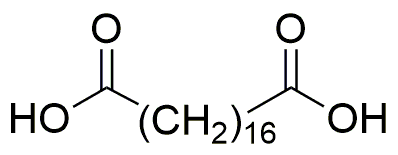Octadecanedioic acid is widely utilized in research focused on:
- Polymer Production: This compound serves as a key ingredient in the synthesis of polyamides and polyesters, which are essential in manufacturing durable plastics and fibers used in textiles and automotive parts.
- Cosmetic Formulations: Its emollient properties make it a valuable addition to skin care products, providing moisture and improving texture, thus enhancing the overall feel of creams and lotions.
- Food Industry: Used as a food additive, it acts as a stabilizer and emulsifier, improving the consistency and shelf-life of various food products.
- Biodegradable Materials: Researchers are exploring its potential in creating eco-friendly materials, contributing to sustainability efforts in packaging and product design.
- Pharmaceutical Applications: It is being investigated for its role in drug delivery systems, where its properties can help in the controlled release of medications, improving therapeutic efficacy.
General Information
Properties
Safety and Regulations
Applications
Octadecanedioic acid is widely utilized in research focused on:
- Polymer Production: This compound serves as a key ingredient in the synthesis of polyamides and polyesters, which are essential in manufacturing durable plastics and fibers used in textiles and automotive parts.
- Cosmetic Formulations: Its emollient properties make it a valuable addition to skin care products, providing moisture and improving texture, thus enhancing the overall feel of creams and lotions.
- Food Industry: Used as a food additive, it acts as a stabilizer and emulsifier, improving the consistency and shelf-life of various food products.
- Biodegradable Materials: Researchers are exploring its potential in creating eco-friendly materials, contributing to sustainability efforts in packaging and product design.
- Pharmaceutical Applications: It is being investigated for its role in drug delivery systems, where its properties can help in the controlled release of medications, improving therapeutic efficacy.
Documents
Safety Data Sheets (SDS)
The SDS provides comprehensive safety information on handling, storage, and disposal of the product.
Product Specification (PS)
The PS provides a comprehensive breakdown of the product’s properties, including chemical composition, physical state, purity, and storage requirements. It also details acceptable quality ranges and the product's intended applications.
Certificates of Analysis (COA)
Search for Certificates of Analysis (COA) by entering the products Lot Number. Lot and Batch Numbers can be found on a product’s label following the words ‘Lot’ or ‘Batch’.
*Catalog Number
*Lot Number
Certificates Of Origin (COO)
This COO confirms the country where the product was manufactured, and also details the materials and components used in it and whether it is derived from natural, synthetic, or other specific sources. This certificate may be required for customs, trade, and regulatory compliance.
*Catalog Number
*Lot Number
Safety Data Sheets (SDS)
The SDS provides comprehensive safety information on handling, storage, and disposal of the product.
DownloadProduct Specification (PS)
The PS provides a comprehensive breakdown of the product’s properties, including chemical composition, physical state, purity, and storage requirements. It also details acceptable quality ranges and the product's intended applications.
DownloadCertificates of Analysis (COA)
Search for Certificates of Analysis (COA) by entering the products Lot Number. Lot and Batch Numbers can be found on a product’s label following the words ‘Lot’ or ‘Batch’.
*Catalog Number
*Lot Number
Certificates Of Origin (COO)
This COO confirms the country where the product was manufactured, and also details the materials and components used in it and whether it is derived from natural, synthetic, or other specific sources. This certificate may be required for customs, trade, and regulatory compliance.

